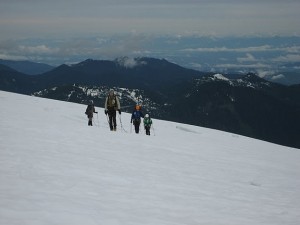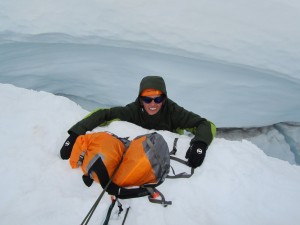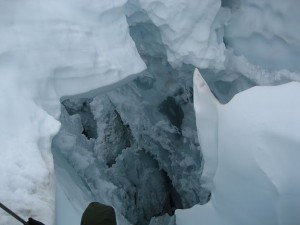This was the first day for a potential summit attempt, and the night before we went to bed with the warning that we would likely be awoken at 2 AM to make the push. I woke at 2 AM, and again at 3 AM to hear our instructors talking in the tent next door, but the call to get up never came. Forest and Margaret ultimately decided to postpone the attempt to give us an entire day to practice crevasse rescue, and to hopefully get slightly better weather for the actual attempt. They were afraid that if we did the summit attempt early, we would not be motivated to do anything the next day. What excellent foresight these guides have! Breakfast that morning was relaxed, but became increasingly exciting as we saw a sleeping mat from a campsite above us fly into the air. At first we sat watching as the mat and stuff sacks slid down the mountain, discussing the other group’s misfortune. Seconds later, however, a sleeping bag took flight – a much more serious situation. Our group immediately went scrambling out on the mountain to recover the articles. We returned them back up to their owners and returned to our camp, newly motivated to check the rocks holding down our tents. While smugly commenting on the other groups misfortune (amusingly, they didn’t realize their stuff had gone airborne, even as we shouted to try and alert them) we saw a rain-fly literally sweep up into a funnel of air and shoot up 100 feet into the air and down the mountain. As we gaped at the spectacle of a large green tarp floating high above us, our guide shouted “Here comes the tent!” We looked up the mountain and saw a large tent rolling end-over-end towards us. The men of our team sprinted out into the snow to try and corral the tent, and Forest managed to get into its path and football tackle the tent. Once again we hiked uphill, and it was returned, without the fly, back to its campsite (this time with heavy rocks put on top of it). Apparently it is common for people to return from a summit climb and think that their tent or supplies have been stolen, as their campsite has been swept clean by the wind. With the excitement of the morning past, we put our harnesses on and roped in as a team to walk onto the glacier so Forest and Margaret could locate the perfect crevasse to practice our rescue techniques.
After an hour and a half or so of hiking, we eventually reached an area of the glacier that was riddled with large crevasses. Our guides brought us to a halt so they could confer with one another, and soon we were hunting through the field looking for the perfect crevasse. After a short search, Forest and Margaret settled on a nice, large crevasse with no overhang and a smooth lip for us to leap off of into the deeps. At this point Forest began probing the ground around us with an avalanche probe to make sure we were on safe ground, and he soon marked off a safe perimeter for us to operate in, unroped. The ropes were quickly taken off, some extra layers were put on to ward off the cold, and we gathered around for some more instruction. After a quick review of the crevasse rescue procedure, we set to work building snow anchors to safely hold us while we worked in the crevasse. Once that was done, it was time for someone to jump into the crevasse. Two rope teams were operating at once, with each team having a rescuer and a victim. I was first up for the victim on our team, with Libby being my rescuer. (For those that worry, each rope was attached to a primary snow anchor, a secondary snow anchor, had an instructor holding it on belay, and was of course attached to the rescuer. Any one of those points are capable of stopping a fall).
Soon enough, I was sliding into the crevasse, and Libby was stopping my fall and trying to rescue me. Shortly afterwards, JR dropped into the crevasse beside me, and we settled down for a pleasant half hour of looking at the crevasse, taking pictures, and eventually discussing skiing and software. Eventually Libby started hauling me up, and before you knew it I was back on solid ground. Next up it was my turn to rescue Dave, the boisterous software engineer. He leaped into the abyss, I fell to the ground to arrest the fall, and took my turn setting up the rescue system. Rescuing someone from a crevasse, for those who are interested, involves transferring the fallen person’s weight off of you to an anchor, roping yourself safely to the anchor so you can check the victim for injuries, and then setting up a series of pulleys and “ratchets” using carabiners and knots so you can pull up the victim without losing ground if you drop the rope.
Generally you set things up so that you pull with a 6-to-1 pull ratio, which allows you to rescue people much larger than yourself. Not to blow my own horn or anything, but It was here that my aptitude for knots (and my studying of Freedom of the Hills before the course) came in handy, as I proceeded to haul Dave out of the crevasse in less than 10 minutes, a full 20 minutes faster than anyone else. (Our guides words: “That system was regurgitated like a true engineer”). Unfortunately, that left Everette, the 15 year old kid on our trip, down in the crevasse by himself. Worse, his rescuer accidentally tangled all of his rope, and forgot to rig up a few knots ahead of the fall, so he spent by the far the longest time in the crevasse. By the time we pulled him out, he was in full-blown freakout mode, and needed a little time to recover. The poor kid could be heard shouting every time the rope slipped a little bit and he slid further into the crevasse.
Finally, it was Libby’s turn to go into the crevasse, and Dave’s turn to pull her out. Libby bravely walked up to the edge, sat down, and counted “1, 2, …I can’t do this!”. She then proceeded to sit there at the edge for several minutes, mustering up the courage to leap in. Eventually, she took a deep breath, pushed off the side, and with only a small blood-curdling scream, plummeted 4 feet down into the crack. For this show of bravery, she was rewarded with: peals of laughter from above, as everyone from her rescuer to the guides collapsed to the ground, giggling helplessly. Libby was a trooper, though, and after only a few more small screams (as the rope settled into the snow and slid her further down), pulled out the camera and spent the rest of her time taking pictures of the depths of the crevasse. The inside of the crevasse is actually an awe-inspiring place, as the deep blue ice slices deep out of sight into the glacier, with wild formations, shapes, and caves carved into the sides by dripping water.
Once Libby was safely pulled up, it was time to head back to camp for supper. We proceeded to hike back to camp to boil water and prepare for what we knew would be our summit attempt early the next morning. With everything in camp ship-shape, we slipped into bed early, ready to rise again in 6 hours.


